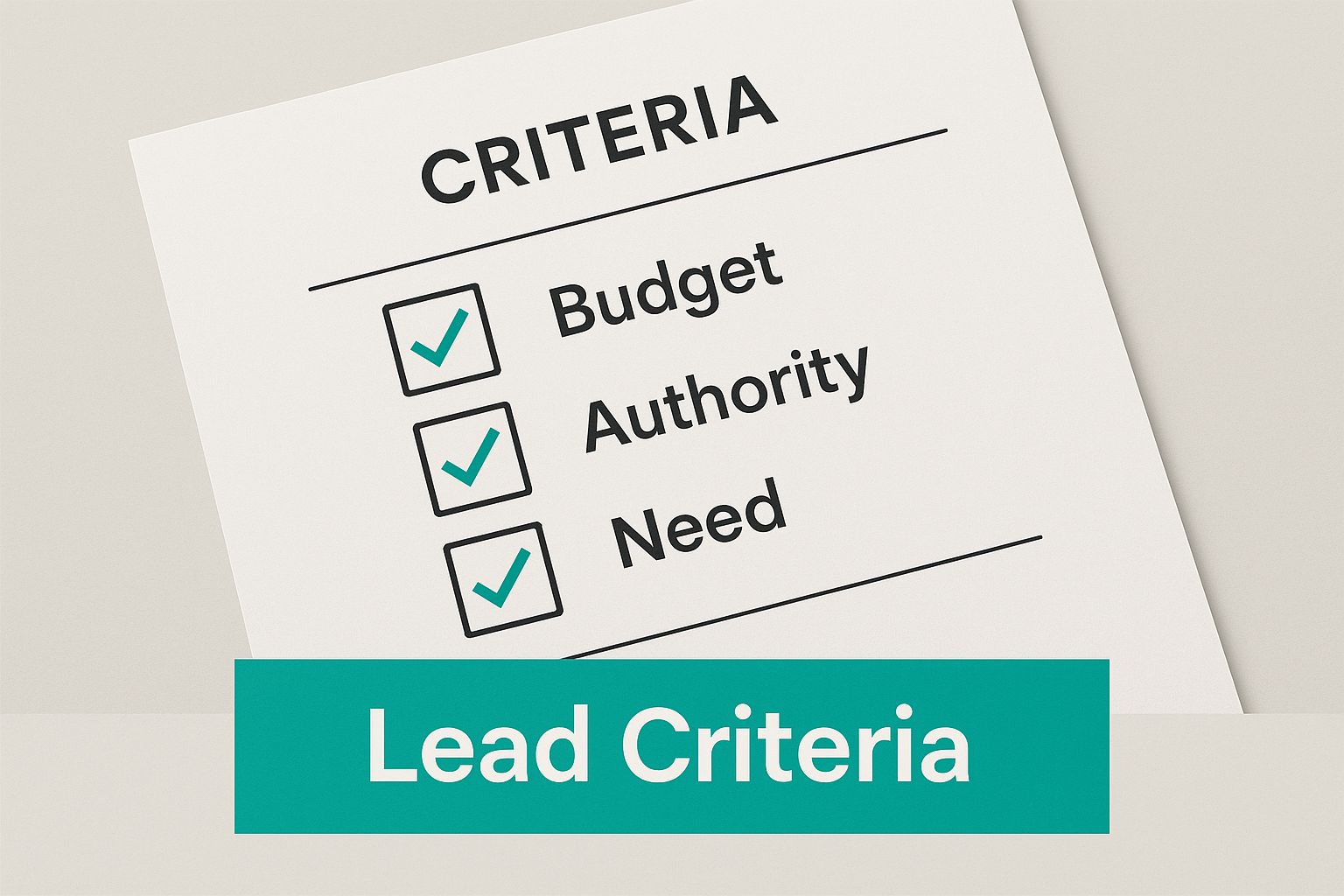Marketing Qualified Leads Definition Guide

So, what exactly is a Marketing Qualified Lead (MQL)? Think of them as a prospect who has shown clear interest in your brand, thanks to your marketing efforts, but isn't quite ready to hop on a sales call. They've essentially raised their hand, signaling they want to learn more before making a final decision. MQLs are the crucial bridge between your broad marketing audience and your highly focused sales team.
Defining a Marketing Qualified Lead

Imagine a visitor at an open house. They aren't just driving by; they've walked in, picked up a brochure, and are asking about the neighborhood. This person is a perfect analogy for a Marketing Qualified Lead. They've moved beyond just passive observation and have started taking actions that show real curiosity.
This concept is the cornerstone of any solid lead generation strategy because it helps separate the casual browsers from those with genuine potential. For a deeper look at how MQLs fit into the bigger picture, check out our beginner's guide to B2B lead generation.
The Two Core Components of an MQL
To really nail down what makes an MQL, you have to look at two distinct but equally important factors: their profile and how engaged they are with your brand.
- Fit (Demographics and Firmographics): This side of the equation answers the question, "Is this the right type of person or company?" It looks at concrete data points like their job title, industry, company size, and location. If a lead lines up with your Ideal Customer Profile (ICP), they’ve got a strong "fit."
- Engagement (Behavioral Data): This part answers, "Has this person shown genuine interest?" It analyzes what they've actually done—like downloading an ebook, signing up for a webinar, or repeatedly visiting your pricing page.
A true MQL sits right at the intersection of both fit and engagement. A CEO from your target industry (great fit) who only visited your homepage once is not an MQL. Likewise, an intern (poor fit) who downloaded every single one of your whitepapers is also not an MQL.
How MQLs Are Identified
Ultimately, a Marketing Qualified Lead is defined as a lead who is more likely to become a customer based on who they are and what they've done. To pinpoint these individuals, marketing teams use a detailed scoring system that combines all that demographic, firmographic, and behavioral data.
This system gives different weights to various actions, like downloading content, attending a demo, or making repeat visits to key web pages. Once a lead hits a specific score, they're officially an MQL and get passed over to the sales team for the next steps. This methodical approach makes sure your sales team’s time is spent on prospects who have not only shown interest but also match the profile of your best customers.
Mapping The Journey From Visitor To Customer
A Marketing Qualified Lead is a huge milestone, but it's just one stop on a much longer journey. To really nail your growth strategy, you need to understand the complete path someone takes—from an anonymous website visitor all the way to a paying customer. The best way to think about this is like a sophisticated filtering system that gets progressively smarter at spotting the most promising people at each stage.
This journey often kicks off when a visitor becomes a Subscriber, maybe by signing up for your newsletter. From there, they might become a Lead by downloading something juicier, like an ebook, which requires them to share a bit more information about themselves. Each step filters the crowd, nudging them closer to a potential sale.
The Great Divide From Marketing To Sales
The jump from a general Lead to an MQL is where things get serious. A Lead is interested in your educational content, but an MQL has shown they’re interested in your actual solution. This is the critical handoff point where marketing’s broad nurturing efforts pivot to sales' much more direct engagement.
Let's look at a practical example:
- Lead: Downloads a top-of-funnel ebook titled "5 Industry Trends for 2024." They're just learning about the space.
- MQL: Requests a product demo or keeps coming back to your pricing page. They're actively evaluating a specific solution.
This infographic lays out how specific criteria help you tell one lead stage from another, making sure the handoff is as smooth as possible.

This checklist-style approach guarantees that only leads who have shown genuine purchase intent get passed over to the sales team. It's a system designed to protect everyone's time and focus resources where they'll have the biggest impact.
To see how these stages fit together, let's break down the entire lead lifecycle.
Understanding The Lead Lifecycle Stages
| Lead Stage | Definition | Example Action |
|---|---|---|
| Subscriber | Someone who has opted into your communications but shared minimal information. | Signs up for your blog newsletter. |
| Lead | A contact who has shown more interest by exchanging information for a content offer. | Downloads a whitepaper or an ebook. |
| MQL | A lead who has been vetted by marketing as ready for a sales conversation. | Requests a product demo or fills out a "Contact Us" form. |
| SQL | A lead that the sales team has accepted and confirmed is a legitimate prospect. | A sales rep has a qualifying call and confirms budget and need. |
| Opportunity | An SQL who has a real, tangible deal in progress with a sales rep. | Receives a formal proposal or quote. |
| Customer | The end goal! An opportunity that has closed and purchased your product or service. | Signs a contract and pays the first invoice. |
Each stage represents a deeper level of commitment and interest, guiding your team on how to engage with them appropriately.
Qualifying Leads For The Final Stages
Once a lead hits the MQL criteria, the sales team takes the baton to qualify them even further. If the lead is a good fit and still shows strong purchase intent, they graduate to become a Sales Qualified Lead (SQL). This means they’ve been properly vetted by a sales rep and are now considered a viable prospect.
The MQL to SQL handoff is a notorious leaky bucket. A staggering 79% of marketing leads never convert to sales, often because they weren't nurtured properly. A crystal-clear definition and process are absolutely essential to avoid this and ensure good leads don’t fall through the cracks.
The final stage is turning that SQL into an Opportunity, which is where a formal sales process kicks off with a proposal and negotiation. This whole structured lifecycle is designed to transform casual curiosity into a solid business relationship. When you map out the entire journey, you can see exactly why the marketing qualified leads definition is so crucial—it’s the gatekeeper that makes sure sales conversations are saved for those who are genuinely ready to talk business.
How to Build a Powerful MQL Scoring System

Okay, let's move from theory to action. Building a solid MQL scoring system is how you translate all those audience signals into real sales opportunities. Think of it as a game where prospects earn points for every action that nudges them closer to buying. Once they hit a certain score, they’ve "won" a conversation with your sales team.
This system isn’t just about counting clicks. It's about assigning real value to a prospect’s "digital body language." A well-built model makes sure only the most engaged and best-fit leads get flagged, saving your sales reps from chasing people who are just window shopping. It puts a number on interest and fit, making the marketing qualified leads definition an actual, usable metric in your business.
Combining Explicit and Implicit Data
A powerful scoring system has to balance two kinds of information: what prospects tell you outright and what their actions show you.
- Explicit Data (Demographics & Firmographics): This is the straightforward, factual stuff a lead gives you, like their job title, company size, industry, or location. It helps you see if they fit your ideal customer profile (ICP).
- Implicit Data (Behavioral): This is what you figure out from a lead's actions. It reflects how engaged and interested they are—think pages visited, content downloaded, or emails opened.
Relying on just one of these is a recipe for mistakes. A lead who's a perfect fit on paper but shows zero engagement isn't ready. And a super-engaged lead who’s a terrible fit is just a waste of time. The real magic happens when you score both.
Assigning Point Values That Work
The heart of your system is assigning points to different attributes and actions. Your main goal is to set a threshold—a specific score—that, once crossed, automatically flips a lead into an MQL. There's no universal set of numbers, but having a logical framework is everything.
Get your sales and marketing teams in a room to agree on the MQL threshold. Let's say you land on 100 points. From there, you can work backward to assign values to everything else.
Example Scoring Framework:
| Category | Action or Attribute | Assigned Points |
|---|---|---|
| High-Intent Actions | Requested a Demo | +25 |
| Visited the Pricing Page (3+ times) | +15 | |
| Started a Free Trial | +30 | |
| Mid-Intent Actions | Downloaded a Case Study | +10 |
| Attended a Webinar | +10 | |
| Subscribed to Newsletter | +5 | |
| Profile Fit (Explicit) | Job Title is "Director" or higher | +15 |
| Company Size is 50-250 Employees | +10 | |
| Negative Actions | Visited the Careers Page | -20 |
| Unsubscribed from Emails | -25 | |
| Is from a Student Email Domain | -50 |
Key Takeaway: Always reserve the highest point values for actions that scream "I want to buy," like a demo request. Negative scoring is just as important for weeding out job seekers, students, or competitors who aren't genuine prospects.
This isn't a "set it and forget it" system. You have to keep refining these values. Dig into your closed-won deals and look for patterns in the behaviors and attributes of your best customers, then tweak your scoring model to match. For a modern take on this, understanding AI-powered relevancy scoring in digital marketing can offer some valuable new perspectives.
This data-first approach takes the guesswork out of the equation, ensuring the MQLs you pass over are genuinely promising. For those looking to put this on autopilot, learning more about https://intently.ai/blog/the-complete-guide-to-ai-lead-generation-tools is a great next step.
Understanding the MQL vs SQL Handoff
This is the exact moment where many marketing funnels break down. The transition from a Marketing Qualified Lead (MQL) to a Sales Qualified Lead (SQL) needs to be sharp and clear to keep things moving. Without a solid process, promising leads can get lost in a confusing limbo between teams and eventually just fade away.
Think of it this way: an MQL is like someone researching different car brands online. They’re comparing features, reading reviews, and showing genuine interest. An SQL, however, is the person who has walked into a specific dealership and asked to test drive a particular car. One is exploring; the other is actively considering a purchase.
Defining the Handoff Point
The key difference really boils down to purchase intent. An MQL shows interest in solving a problem, while an SQL shows interest in your solution to that problem.
Marketing’s job is to nurture the researcher, feeding them valuable content and building trust. Once that interest shifts from general education to specific product evaluation, it's time for sales to step in.
This is the point where lead ownership officially changes hands. Marketing has successfully guided the prospect, and now it’s the sales team’s job to engage them directly, answer product-specific questions, and guide them toward buying. Botching this handoff can frustrate your teams and, even worse, the potential customer.
The Criteria Sales Teams Use
Before a sales team accepts an MQL and promotes it to an SQL, they vet the lead against a specific set of criteria. A classic way to remember this is the acronym BANT.
- Budget: Does the lead have the cash to actually make a purchase?
- Authority: Is this person the decision-maker, or at least someone who can influence the decision?
- Need: Does our product genuinely solve a real, pressing pain point for them?
- Timeline: Are they looking to buy sometime in the near future?
If an MQL checks these boxes, they are officially accepted as an SQL. This qualification step is crucial; it makes sure sales reps focus their valuable time on leads with a real chance of closing. For a deeper look into the nitty-gritty of this process, there are great resources on how to qualify sales leads.
A lead becomes sales-qualified when they have the information needed to make a decision, the budget and resources to make the purchase, and executive buy-in. When these elements align, a one-on-one consultation can turn these leads into revenue.
By setting up a clear definition for your MQLs and a strict set of SQL criteria, you build a seamless bridge between your teams. This alignment ensures every lead is handled by the right person at the right time with the right message, which can dramatically improve your conversion rates.
Optimizing the Handoff to Your Sales Team
So you’ve perfectly defined what a Marketing Qualified Lead looks like. That’s a huge step, but it’s worthless if the handoff to sales gets fumbled. This transition is where all your marketing momentum is either captured or lost completely.
Think of it like a relay race. A sloppy baton pass can cost you the win, no matter how fast your runners are. To keep that from happening, marketing and sales have to operate from the same playbook.
That shared playbook is called a Service Level Agreement (SLA). It’s a formal document that strips away all the guesswork. A solid SLA clearly outlines the agreed-upon marketing qualified leads definition, the exact lead score that triggers the handoff, and—this part is critical—how quickly the sales team has to follow up. A common rule is within 24 hours, but let's be real, faster is always better.
Arming Sales with Contextual Intelligence
Just tossing a name and an email address over the fence isn't going to cut it. For that first conversation to feel personal and actually be effective, your sales reps need context. That means every MQL should come with a rich history of their interactions.
What kind of information is essential?
- Engagement History: Which blog posts did they read? What specific pages on your website did they visit most often?
- Content Consumed: Did they download a high-level ebook, or was it a bottom-of-funnel case study?
- Origin Source: How did they find you in the first place? An organic search, a social media ad, or a referral?
This background info transforms a potentially cold interaction into a relevant, helpful conversation. It kills the awkward "So, what do you know about us?" opener and lets the rep jump right in with something like, "I see you were interested in our case study on X; I can tell you more about how we achieved those results." Understanding this context is a game-changer, especially when you realize that traditional cold outreach doesn't work anymore.
Building a Collaborative Revenue Engine
Friction between sales and marketing almost always comes back to a broken handoff process. When sales feels like the leads are low-quality, they stop following up. When marketing sees their qualified leads getting ignored, they get frustrated. It's a vicious cycle that kills trust and stalls growth.
A robust handoff process isn't just about efficiency; it's about building a single, unified revenue engine. It requires constant communication, feedback loops, and a shared commitment to refining the process based on what actually converts.
This collaboration is everything. The data doesn't lie: a staggering 67% of lost sales happen because of poor lead qualification, and only about 25% of marketing-generated leads are ever truly ready for a direct sales conversation.
But here's the good news. By implementing strong lead nurturing programs and a tight handoff, companies can boost their sales-ready leads by 50% while cutting costs by 33%. This proves a well-oiled handoff isn't just a "nice to have"—it's a core driver of your revenue.
Untangling Common MQL Program Knots
Even the most carefully planned MQL program is going to hit some snags. Getting your system live is just the starting line; the real work is in the constant tuning and troubleshooting that comes after. When you hit a roadblock, it's a signal to diagnose the problem, not to ditch the whole system.
Most of the friction you’ll encounter boils down to a few usual suspects. A classic is the low MQL-to-SQL conversion rate. If sales is only accepting a tiny fraction of the leads marketing is handing over, that’s a massive red flag that your scoring criteria are too loose or your marketing qualified leads definition is out of sync with what the sales team actually needs.
Another common headache is getting direct pushback from the sales team about lead quality. When they consistently tell you the leads aren't ready for a conversation, you know there's a serious disconnect between the two teams on what a "sales-ready" prospect really looks like.
How to Diagnose and Fix Your MQL Problems
When you see performance start to dip, it’s time to get specific. Don't just start randomly adjusting lead scores and hoping for the best. You need to dig into the data and find the real root cause.
Here are a few practical steps you can take to get your MQL program back on solid ground:
- Work Backwards from Your Wins: Pull up your last 10-20 closed-won deals and trace their steps. What specific actions did those customers take right before they talked to sales? Those are your golden nuggets. Make sure those high-value actions are worth more points in your lead scoring model.
- Get Sales and Marketing in a Room Together: Schedule regular alignment workshops. The agenda is simple: pull up a handful of recently rejected MQLs and have a real, candid conversation about why they weren't ready. This kind of direct, collaborative feedback is pure gold.
- Get Smarter with Negative Scoring: Are you doing enough to filter out the tire-kickers and job seekers? Add or increase the negative point values for actions that signal someone isn't a real prospect, like visiting your careers page or signing up with a student email address.
The point of an MQL program isn't just to generate a massive volume of leads—it's to generate the right leads. Quality will always beat quantity when you're trying to build a predictable revenue engine.
It’s no surprise that 50% of marketers globally consider lead generation a top priority. But here's the catch: a separate study found that 44% of sales reps feel they're too swamped to follow up on every single lead. This just underscores how critical good qualification is. You need to make sure the best MQLs—which can cost an average of $198 to acquire—get the attention they need. You can dive deeper into these numbers by exploring the full lead generation statistics.
By proactively tackling these challenges, you can stop the finger-pointing and turn your MQL program into a well-oiled machine that consistently feeds your sales pipeline with high-quality, engaged prospects.
Frequently Asked Questions About MQLs
Even with the best strategy laid out, real-world questions always pop up when you're in the trenches managing MQLs. Here are some clear, straightforward answers to the questions we hear most often. Think of this as your quick guide to smoothing out the process before any issues can slow you down.
What Is a Good MQL to SQL Conversion Rate?
While the numbers can shift depending on your industry, a healthy MQL-to-SQL conversion rate usually lands somewhere between 10% and 30%. If your rate is dipping way below that, it’s a strong signal that your MQL criteria might be too loose or that marketing and sales aren't quite on the same page.
On the flip side, if you're consistently converting way above 30%, you might actually be too strict. That could mean you're leaving behind some solid opportunities that just needed a little more time in a nurture sequence. The key is to keep a close eye on this number and be ready to tweak your scoring model.
A chronically low conversion rate is almost always the first sign of a disconnect between marketing and sales. Use it as a reason to get everyone in a room and hash out your definition of a marketing qualified lead.
How Often Should I Review My MQL Definition?
Your MQL definition should never be a "set it and forget it" kind of thing. The best practice is to get together with stakeholders from both marketing and sales to review your lead scoring and MQL criteria at least once a quarter.
Take a hard look at your recent closed-won deals. What did those customers have in common? What actions did they take? Use those insights to adjust your scoring rules so they actually reflect what signals a person is ready for a sales call. Markets change and so do ideal customers, so your definition needs to evolve right along with them.
Can a Lead Be Recycled Back to Marketing?
Absolutely, and they should be. If the sales team talks to an MQL and finds they aren't quite ready to buy, that lead should never just be thrown away. The right move is to "recycle" them back into marketing's nurturing programs.
This simple process makes sure you don't lose out on someone who’s interested but just needs more information or time. After they’ve seen a few more blog posts or joined another webinar, they might just take another high-intent action and pop back up as a qualified MQL, ready for a real conversation.
Ready to stop searching for leads and start engaging with them? Intently uses AI to monitor social channels for high-intent conversations, delivering qualified prospects directly to you. Discover your next customer.
